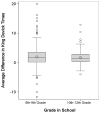King-Devick and Pre-season Visual Function in Adolescent Athletes
- PMID: 27464573
- PMCID: PMC5182104
- DOI: 10.1097/OPX.0000000000000938
King-Devick and Pre-season Visual Function in Adolescent Athletes
Abstract
Purpose: The King-Devick test (KD) has been studied as a remove-from-play sideline test in college-age athletes and older; however, studies in younger athletes are limited. A cross-sectional study of the KD and other vision correlates was completed on school-aged athletes during pre-season physicals for a variety of sports to determine the repeatability of the KD. The study also evaluated how convergence, alignment, or pupil function contributed to a slower King-Devick baseline reading.
Methods: Seven hundred eighty-five athletes underwent vision screenings in a hospital or school setting by trained/certified staff as part of pre-season physicals. Six hundred nineteen had KD testing completed per the manufacturer's suggested protocol and repeated. Other baseline vision testing included visual acuity, Modified Thorington testing for alignment, convergence testing, and pupil function using the NeurOptics (NPI-200) NPi.
Results: The mean fastest, error-minimized KD time for all participants was 43.9 seconds(s) (SD ± 11.6, range 24-120). Median KD time got faster (+) with age (p < 0.0001). The inter-class correlation coefficient for all scores was 0.92. The absolute mean time difference for any two tests was 3.5 s (SD ± 2.5, range 0-23). There was no association between the best KD time and reduced NPC (p = 0.63), Modified Thorington measure of alignment (p = 0.55), or NPi pupil function (p = 0.79). The Bland Altman repeated measure limits of agreement was ±6.5 seconds for those in the 10th to12th grades, and ±10.2 seconds for those in the 6th to 9th grades.
Conclusions: King-Devick score in junior high and high school athletes is variable but gets faster and more repeatable with increasing age. The KD does not correlate significantly with reduced convergence, alignment, or pupil function. Based on grouped data, a slowing of 10 seconds for younger athletes and 6 seconds for older athletes on a second administration represents a true difference in testing speed. Within-player variability should be considered when removal-from-play decisions are influenced by KD results.
Figures
Similar articles
-
King-Devick Test Reliability in National Collegiate Athletic Association Athletes: A National Collegiate Athletic Association-Department of Defense Concussion Assessment, Research and Education Report.J Athl Train. 2019 Dec;54(12):1241-1246. doi: 10.4085/1062-6050-219-18. Epub 2019 Oct 16. J Athl Train. 2019. PMID: 31618072 Free PMC article.
-
The King-Devick test and sports-related concussion: study of a rapid visual screening tool in a collegiate cohort.J Neurol Sci. 2011 Oct 15;309(1-2):34-9. doi: 10.1016/j.jns.2011.07.039. Epub 2011 Aug 16. J Neurol Sci. 2011. PMID: 21849171
-
Test Performance and Test-Retest Reliability of the Vestibular/Ocular Motor Screening and King-Devick Test in Adolescent Athletes During a Competitive Sport Season.Am J Sports Med. 2018 Jul;46(8):2004-2010. doi: 10.1177/0363546518768750. Epub 2018 May 9. Am J Sports Med. 2018. PMID: 29741916 Clinical Trial.
-
Is the King-Devick Test a Reliable Tool in Wheelchair Athletes? A Preliminary Prospective Study in Wheelchair Basketball.Clin J Sport Med. 2022 Mar 1;32(2):e134-e138. doi: 10.1097/JSM.0000000000000889. Clin J Sport Med. 2022. PMID: 32956101
-
American Medical Society for Sports Medicine position statement: concussion in sport.Br J Sports Med. 2013 Jan;47(1):15-26. doi: 10.1136/bjsports-2012-091941. Br J Sports Med. 2013. PMID: 23243113 Review.
Cited by
-
The King-Devick test in an outpatient concussion clinic: Assessing the diagnostic and prognostic value of a vision test in conjunction with exercise testing among acutely concussed adolescents.J Neurol Sci. 2019 Mar 15;398:91-97. doi: 10.1016/j.jns.2018.12.020. Epub 2018 Dec 22. J Neurol Sci. 2019. PMID: 30690413 Free PMC article. Clinical Trial.
-
Discovering Oculometric Patterns to Detect Cognitive Performance Changes in Healthy Youth Football Athletes.J Healthc Inform Res. 2019 Feb 8;3(4):371-392. doi: 10.1007/s41666-019-00045-4. eCollection 2019 Dec. J Healthc Inform Res. 2019. PMID: 35415432 Free PMC article.
-
Assessing Brain Processing Deficits Using Neuropsychological and Vision-Specific Tests for Concussion.Sports (Basel). 2024 Apr 29;12(5):125. doi: 10.3390/sports12050125. Sports (Basel). 2024. PMID: 38786994 Free PMC article.
-
Neurosensory Screening and Symptom Provocation in Pediatric Mild Traumatic Brain Injury.J Head Trauma Rehabil. 2020 Jul/Aug;35(4):270-278. doi: 10.1097/HTR.0000000000000560. J Head Trauma Rehabil. 2020. PMID: 32108710 Free PMC article.
-
Socioeconomic status and race as social determinants of health to be considered in clinical use of pre-season vestibular and oculomotor tests for concussion.J Clin Transl Res. 2020 Oct 7;6(4):168-178. eCollection 2020 Nov 15. J Clin Transl Res. 2020. PMID: 33501387 Free PMC article.
References
-
- Centers for Disease Control and Prevention, Morbidity and Mortality Weekly Report (MMWR) Nonfatal Traumatic Brain Injuries Related to Sports and Recreation Activities among Persons Aged ≤19 Years — United States, 2001–2009. [Accessed January 14, 2016];MMWR. 2011 60:1337–42. Available at: http://www.cdc.gov/mmwr/preview/mmwrhtml/mm6039a1.htm. - PubMed
-
- McCrory P, Meeuwisse W, Aubry M, Cantu B, Dvořák J, Echemendia R, Engebretsen L, Johnston K, Kutcher J, Raftery M, Sills A, Benson B, et al. Consensus statement on Concussion in Sport - The 4th International Conference on Concussion in Sport held in Zurich, November 2012. Phys Ther Sport. 2013;14:e1–e13. - PubMed
-
- Master CL, Scheiman M, Gallaway M, Goodman A, Robinson RL, Master SR, Grady MF. Vision diagnoses are common after concussion in adolescents. Clin Pediatr (Phila) 2016;55:260–7. - PubMed
-
- Stelmack JA, Frith T, Van Koevering D, Rinne S, Stelmack TR. Visual function in patients followed at a Veterans Affairs polytrauma network site: an electronic medical record review. Optometry. 2009;80:419–24. - PubMed
-
- Brahm KD, Wilgenburg HM, Kirby J, Ingalla S, Chang CY, Goodrich GL. Visual impairment and dysfunction in combat-injured service members with traumatic brain injury. Optom Vis Sci. 2009;86:817–25. - PubMed
MeSH terms
Grants and funding
LinkOut - more resources
Full Text Sources
Other Literature Sources
Medical


